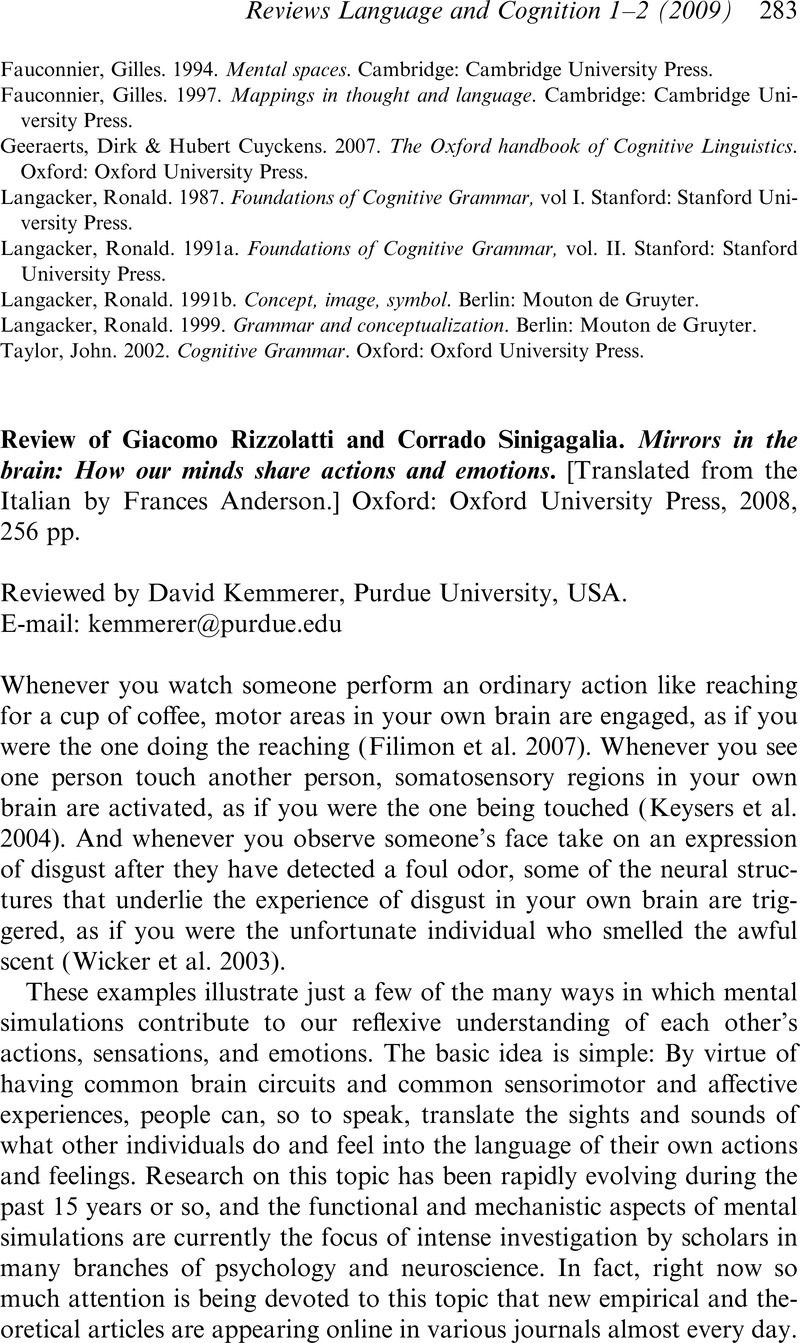No CrossRef data available.
Article contents
Review of Giacomo Rizzolatti and Corrado Sinigagalia. Mirrors in the brain: How our minds share actions and emotions. [Translated from the Italian by Frances Anderson.] Oxford: Oxford University Press, 2008, 256 pp.
Published online by Cambridge University Press: 11 March 2014
Abstract
An abstract is not available for this content so a preview has been provided. Please use the Get access link above for information on how to access this content.

- Type
- Reviews
- Information
- Copyright
- Copyright © UK Cognitive Linguistics Association 2009
References
Aglioti, S. M., Cesari, P., Romani, M. & Urgesi, C.. 2008. Action anticipation and motor resonance in elite basketball players. Nature Neuroscience 11. 1109–1116.Google Scholar
Arbib, M. A. 2005. From money-like action recognition to human language: An evolutionary framework for neurolinguistics. Behavioral and Brain Sciences 28. 105–167.Google Scholar
Corballis, M. C. 2002. From hand to mouth: The origins of language. Princeton, NJ: Princeton University Press.Google Scholar
Cross, E. S., Grafton, S. T. & Hamilton, A. F.. 2006. Building a motor simulation de novo: Observation of dance by dancers. NeuroImage 31. 1257–1267.Google Scholar
Filimon, F., Hagler, D. J., Nelson, J. D. & Sereno, M. I.. 2007. Human cortical representations for reaching: Mirror neurons for execution, observation, and imagery. NeuroImage 37. 1315–1328.Google Scholar
Evangeliou, M. N., Galletti, C., Raos, V. & Savaki, H. E.. 2009. Functional imaging of the parietal cortex during action execution and observation. Cerebral Cortex 19. 624–639.Google Scholar
Gazzola, V. & Keysers, C.. 2009. The observation and execution of actions share motor and somatosensory voxels in all tested subjects: Single-subject analyses of unsmoothed fMRI data. Cerebral Cortex 19. 1239–1255.Google Scholar
Keysers, C., Anton, L., Fogassi, J. L., Gallese, V., Gazzola, V. & Wicker, B.. 2004. A touching sight: SII/PV activation during the observation and experience of touch. Neuron 42. 335–346.Google Scholar
Negri, G. A. L., Caramazza, A., Mahon, B. Z., Rumiati, R. I., Ukmar, M. & Zadini, A.. 2007. What is the role of motor simulation in action and object recognition? Evidence from apraxia. Cognitive Neuropsychology 24. 795–816.Google Scholar
Raos, V., Evangeliou, M. N. & Savaki, H. E.. 2007. Mental simulation of action in the service of action perception. Journal of Neuroscience 27. 12675–12683.Google Scholar
Wicker, B., Gallese, V., Keysers, C., Plailly, J., Rizzolatti, G. & Royet, J.-P.. 2003. Both of us disgusted in my insula. Neuron 40. 655–664.Google Scholar
Willems, R. M. & Hagoort, P.. 2007. Neural evidence for the interplay between language, gesture, and action: A review. Brain and Language 101. 278–289.Google Scholar
Wood, J. N., Glynn, D. D. & Hauser, M. D.. 2007. The uniquely human capacity to throw evolved from a non-throwing primate: An evolutionary dissociation between action and perception. Biology Letters 3. 360–264.Google Scholar
Wood, J. N. & Hauser, M. D.. 2008. Action comprehension in non-human primates: Motor simulation or inferential reasoning? Trends in Cognitive Sciences 12. 461–465.Google Scholar




